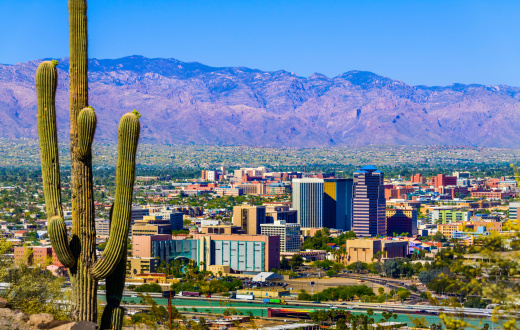Pima County Should Listen to Elvis Presley
“Don’t be cruel” was good advice that should have been heeded long ago.
Elvis Presley released “Don’t Be Cruel” in 1956. Within a couple of decades, Pima County and the City of Tucson began adopting cruel political systems, economic policies, industrial policies, and social policies that set the Tucson metropolis on a course to be a laggard in prosperity and a leader in poverty, as well as the human misery and blight that come with poverty.
The city and county also began despoiling the natural beauty of the area by allowing some of the tackiest development imaginable while also allowing downtown Tucson and much of center city to go to seed.
The first step in solving a problem is admitting that you have one. The good news is that Pima County has admitted that it has one.
It has published a 13-point Prosperity Initiative to increase prosperity and reduce poverty. The initiative even references a 2015 New York Times article, which concluded that Pima County is “among the worst counties in the U.S. in helping poor children up the income ladder.”
Considering that there are 2,478 counties, it takes a special effort to be among the worst.
As I’ve documented in many papers, metro Tucson also ranks near the bottom in other socioeconomic measures.
The bad news is that the Prosperity Initiative is full of platitudes, bromides, and banalities.
It also has an odor of redistribution. Speaking euphemistically, the initiative mentions the shifting of resources to poorer areas. What resources? Despite high sales tax rates and high property tax rates, both the city and the county have a low tax base, due to a dearth of high-paying industries and an influx of fixed-income retirees, low-income service workers from other states, snowbirds who have no tie to the community, students who attend the University of Arizona and then move to greener pastures after graduation, and transients looking for warm weather who skedaddle after experiencing their first summer in the desert.
There is also an influx of poorly skilled and poorly educated migrants from south of the border, a migration that is encouraged by the city and county. That’s a fact, not a xenophobic sentiment.
It’s also a fact that my immigrant grandparents, as well as my wife’s immigrant grandparents, were poorly skilled and educated. But it was easier back then to get by on blue-collar work and for two-parent families to survive with only one parent working, in spite of a government social safety net being virtually nonexistent.
As is evident in Tucson, population growth becomes a negative when the economy and housing grow slower than the population.
In any event, when the county speaks of shifting resources, where are they going to be shifted from? Even relatively wealthy areas of the metropolis—wealthy for Tucson but not wealthy compared to other cities—have crumbling roads, lousy landscaping, spotty code enforcement, mediocre schools, inadequate transportation networks, and inferior public amenities and services. Any further deferred maintenance and cutbacks in these areas will only make the metropolis less desirable to the movers and shakers who decide where to locate not only high-wage operations but also their own families—and who bring capital and a higher tax base to a city.
Dislike the so-called elites if you will, but that’s the reality.
Local government has already shifted considerable resources to the redevelopment of downtown, which is becoming a center for government offices, businesses that feed off the government, condo-dwelling professionals, and low-wage bars and restaurants. Approximately $200 million was squandered when the redevelopment began years ago. At a median household income in the city of roughly $50,000 (but higher for the metro area), that’s equal to a year’s income for 4,000 families. Yet the county wants us to believe that it knows how to reduce poverty.
Instead of taking a lesson from American cities that are more successful than Tucson, the Prosperity Initiative takes a lesson from a nation-state. Using a formula produced by Canada on the economic cost of poverty, the initiative claims that Pima County suffers an economic loss of $2.8 billion a year due to poverty. The implication is that if the county were to spend that much on reducing poverty, it would be a cost-free investment because the costs would be quickly recouped.
Of course, Canada is significantly different from Tucson, especially in demographics. Canada doesn’t track race and ethnicity the way that the U.S. does, but it is estimated that Blacks and Latinos make up only 3.8% and 2.5% of the Canadian population, respectively. For Tucson, the numbers are 4.8% and 44.8%.
Asians account for 19.3% of Canada’s population, versus 3.2% for Tucson, largely the result of Canada’s immigration system, which puts a high value on skills. The percentage of Asians is even higher in Vancouver, where Chinese, South Asians, and Filipinos make up 39.3% of the population. So many wealthy Asians have bought property in Vancouver that many native-born Canadians say that they can no longer afford to live in the city.
These are important statistics, because, generally speaking, the higher the combined percentage of people of Asian and Northern European ancestry in a city, the higher the income and wealth. This holds for both Canada and the U.S.
I’ve traveled on business and pleasure to the Canadian cities of Winnipeg, Calgary, Ottawa, and Quebec. There was a noticeable lack of diversity in those cities, in terms of Blacks and Latinos. (French Canadians don’t count as minorities, although they think of themselves that way.) On the other hand, Canada is rich in natural resources.
It is said that demographics are destiny. It sure seems that’s true when comparing Tucson to Canada. But there are several American cities of Tucson’s size and similar demographics that have escaped the poverty trap. Pima County and the City of Tucson should look to them for ideas instead of Canada. And it wouldn’t hurt to listen to Elvis.




